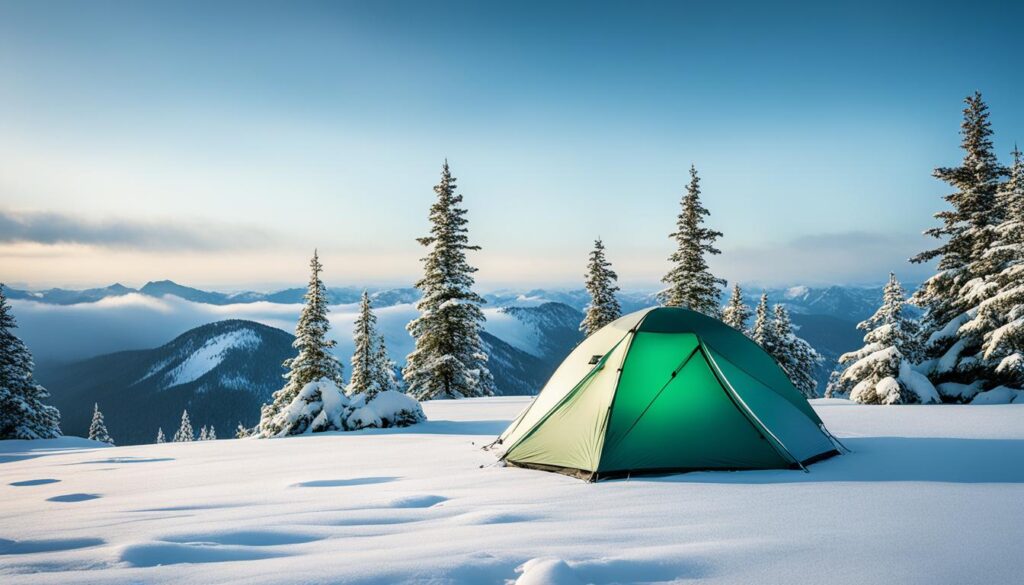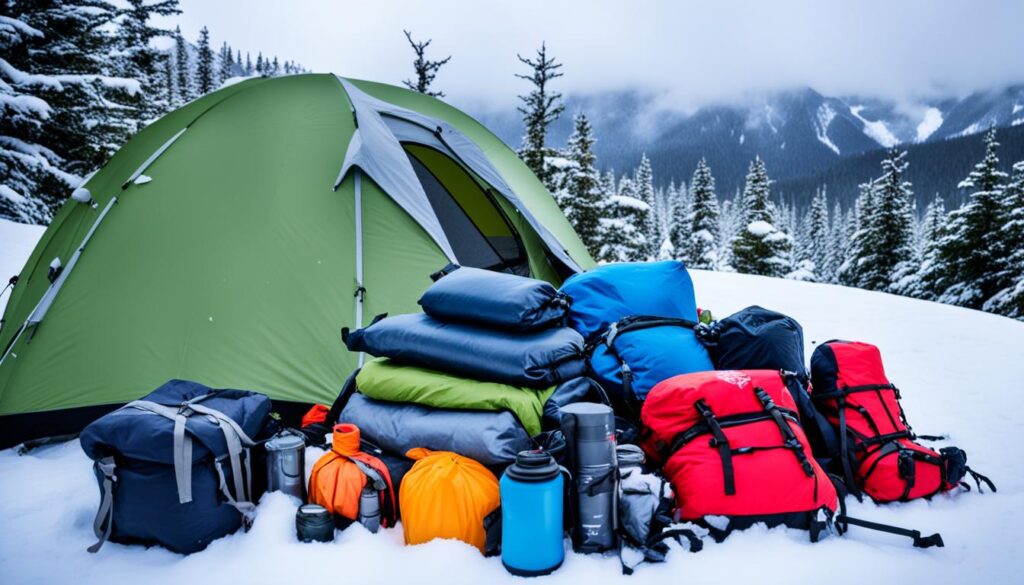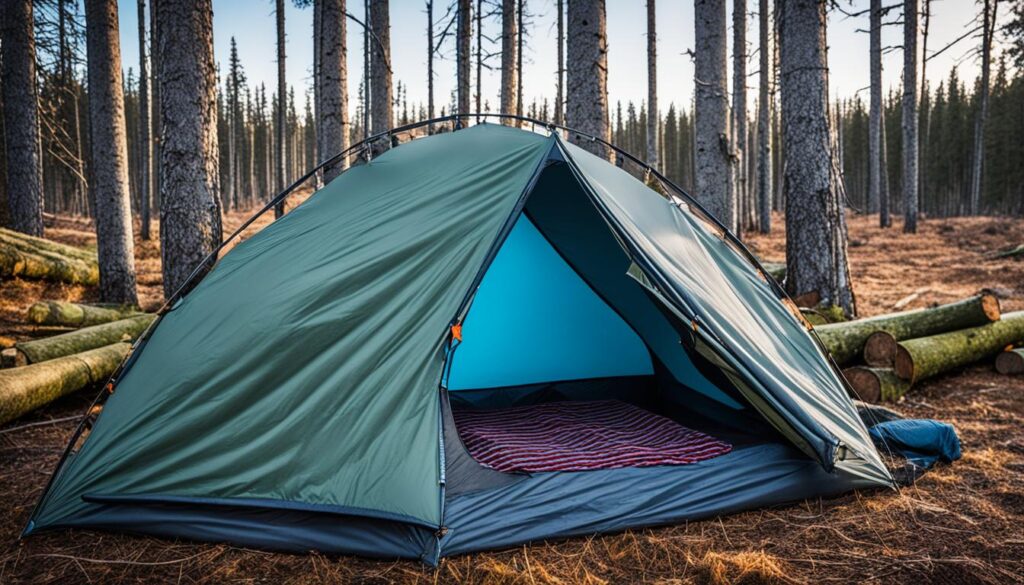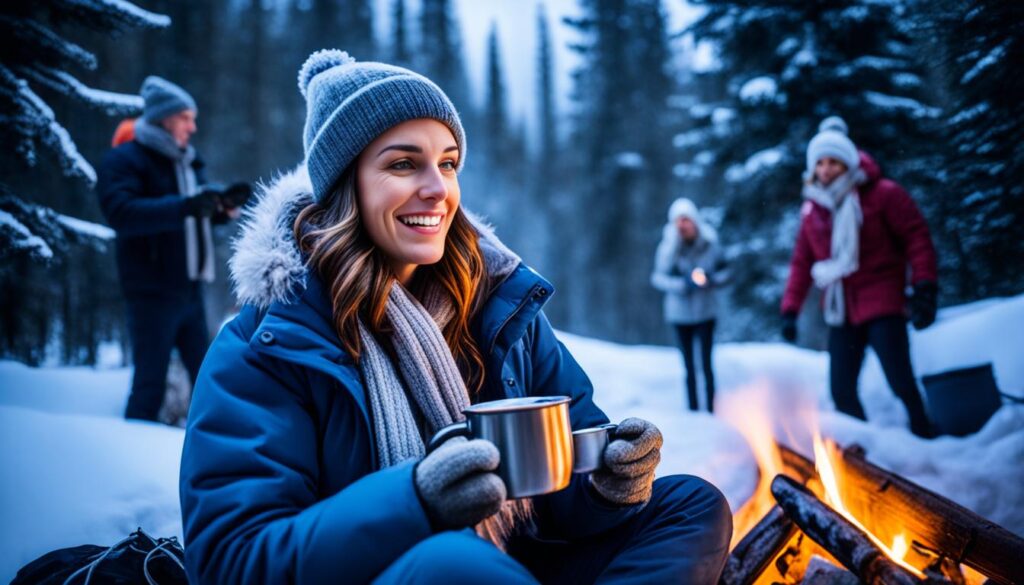As an outdoor enthusiast, I’ve always been captivated by the idea of camping in cold weather. The crisp air, the silent beauty of the snow-covered landscape, and the exhilarating sense of adventure make camping in colder temperatures an enticing experience. However, venturing into the cold requires careful consideration and preparation to ensure both safety and comfort.
When it comes to camping in cold weather, it’s important to know the temperature limits and understand how cold is too cold. While the ideal camping temperature for most people is around 70°F (21°C), which allows for minimal adjustments in gear and preparation, the real challenge lies in temperatures below 50°F (10°C).
Key Takeaways:
- Understanding the temperature limits for camping in cold weather is crucial for a safe and enjoyable experience.
- Experts recommend an ideal camping temperature of around 70°F (21°C), but extra precautions are necessary as temperatures drop below 50°F (10°C).
- It’s important to have the right gear, including a suitable sleeping bag, proper clothing layers, and essential accessories, to stay warm in colder temperatures.
- Temperature tolerance varies among individuals, so it’s essential to know your limits and adjust your gear accordingly.
- Packing the right gear, including a sleeping bag with a suitable temperature rating and a weatherproof tent, is essential for camping in cold weather.
When it comes to camping in cold weather, understanding your own cold tolerance is crucial. Each individual has different limits and needs when it comes to braving the chill. While temperatures ranging from 50°F to 65°F (10°C to 18°C) may be comfortable for many campers, venturing into colder conditions requires additional preparation.
When camping in temperatures below 40°F (4°C), it’s important to be equipped with thicker clothing layers, warm sleeping bags, and specialized cold-weather gear. These essential items will help you stay cozy and protected from the freezing temperatures and unpredictable weather conditions.
As the mercury drops even further, ranging from 30°F to 20°F (-1°C to -6°C), camping in extreme cold becomes even more challenging. Risks such as hypothermia become more prevalent, and proper precautions should be taken. Experienced campers with the best gear and a thorough understanding of cold-weather safety should attempt camping in sub-zero temperatures below 20°F (-6°C).
By knowing your own cold tolerance and investing in the appropriate gear, you can enjoy the beauty of camping even in freezing temperatures. Remember, safety should always be the top priority when camping in extreme cold.
Benefits of Understanding Your Cold Tolerance
Understanding your cold tolerance allows you to plan your camping trip accordingly and make informed decisions about when and where to camp. By knowing your limits, you can choose suitable destinations and prepare the necessary gear to ensure a safe and enjoyable camping experience.
The Importance of Cold-Weather Gear
When camping in extreme cold, the right gear can make all the difference. Investing in quality cold-weather gear, such as insulated jackets, thermal base layers, and weatherproof tents, will help keep you warm and shielded from the elements. The table below highlights some essential cold-weather gear for camping:
| Gear | Description |
|---|---|
| Warm Sleeping Bag | A sleeping bag with a suitable temperature rating to protect against the cold. |
| Insulated Clothing Layers | Thermal base layers and insulated jackets to provide warmth and prevent heat loss. |
| Weatherproof Tent | A tent designed to withstand cold temperatures, wind, and precipitation. |
| Cold-Weather Accessories | Gloves, hats, and scarves to protect extremities from frostbite. |
| Hot Water Bottle | A hot water bottle to warm the sleeping bag during extremely cold nights. |
Remember, having the right gear and understanding your cold tolerance are the keys to a successful and enjoyable camping adventure in freezing temperatures. Stay warm, stay safe!

Gear for Cold Weather Camping: Ensuring Comfort and Safety
Packing the right gear is essential for staying comfortable and safe during cold weather camping. To make the most of your camping experience in low temperatures, consider the following:
Choose the Right Sleeping Bag
When camping in cold weather, it’s crucial to choose a sleeping bag with a temperature rating that matches or exceeds the expected lowest temperature. This will provide you with the necessary insulation and comfort throughout the night. Look for sleeping bags specifically designed for cold weather conditions, such as those with down or synthetic insulation.
Select the Proper Tent
Selecting the right tent is equally important. Look for a tent that offers excellent weatherproofing to keep you dry and well-insulated. Ventilation is also crucial to prevent condensation buildup. Consider factors like size and space, as you’ll need enough room for your gear and to move comfortably inside the tent.
Dress Appropriately
Layering your clothing is essential for cold weather camping. Start with a moisture-wicking base layer to keep sweat away from your body. Add insulating layers to trap heat, and finish with a waterproof and windproof outer layer to protect against the elements. Don’t forget to wear warm socks, gloves, and a hat to keep extremities cozy.
Don't Forget Essential Accessories
In addition to a reliable sleeping bag and tent, there are essential accessories you shouldn’t overlook. A sleeping pad provides an extra layer of insulation between you and the cold ground. A stove allows you to cook warm meals and beverages, boosting your comfort and morale. Lighting ensures visibility during dark hours, and safety gear such as a first aid kit and a whistle are essential in case of emergencies.
To summarize, packing the right gear for cold weather camping enhances your comfort and safety. Choose a suitable sleeping bag, select a proper tent with excellent weatherproofing and ventilation, dress in appropriate layers, and don’t forget essential accessories. By being prepared and equipped with the right gear, you can enjoy your cold weather camping adventure to the fullest.

The Importance of Shelter in Cold Weather Camping
While traditional tent camping is a popular choice for outdoor enthusiasts, it’s crucial to consider alternative shelters and shelter enhancements when braving the cold weather. In this section, I will discuss the various options available to ensure a safe and comfortable camping experience in low temperatures.
Traditional Tent Camping
Traditional tents offer a familiar and convenient shelter option for cold weather camping. However, proper selection and setup are vital to maximize insulation and protect against the elements. When choosing a tent, look for models designed for cold weather conditions, with sturdy construction and features such as a rainfly and ground cloth for added insulation.
It’s essential to set up your tent in a location sheltered from strong winds and potential avalanche paths. This will provide additional protection from the cold and help maintain a stable internal temperature.
Alternative Shelters
If you’re looking for alternatives to traditional tent camping, there are several options to consider:
- Hard-Shell Tents and Campers: These shelters offer superior insulation and often come equipped with built-in heating options. They provide a more robust barrier against cold temperatures and harsh weather conditions.
- Snow Shelters: In extreme winter conditions and deep snow, constructing snow shelters like snow caves or quinzhees can provide stable temperatures. These shelters take advantage of the insulating properties of snow to create a warm and secure space.
Choosing the right shelter depends on the severity of the cold weather and your level of experience. It’s essential to research and practice building alternative shelters before venturing into extreme conditions.
Shelter Enhancements
In addition to selecting the right shelter, there are several enhancements you can utilize to maximize warmth and protection. These include:
- Tarp Overlays: Adding a tarp over your tent can provide an extra layer of insulation and protection against wind and moisture.
- Snow Walls: Building snow walls around your tent can act as a windbreak and help retain heat.
- Reflective Liners: Using reflective liners inside your shelter can help reflect body heat back onto you, increasing warmth.
By implementing these shelter enhancements, you can further improve your camping experience in cold conditions.

To summarize, when camping in cold weather, it’s essential to consider alternative shelters and shelter enhancements to ensure a safe and comfortable experience. Traditional tents should be selected and set up in locations protected from wind and potential avalanche paths. Alternative shelters like hard-shell tents, snow shelters, and shelter enhancements such as tarp overlays, snow walls, and reflective liners can provide additional insulation and protection against the cold. By choosing the right shelter and implementing necessary enhancements, you can stay warm and enjoy your cold weather camping adventure to the fullest.
Essential Tips for Ensuring a Safe and Warm Cold Weather Camping Experience
To ensure a safe and warm cold weather camping experience, there are several essential tips to keep in mind.
Firstly, campsite selection plays a crucial role in cold weather camping. Choose a location that is protected from strong winds, as wind chill can significantly lower the ambient temperature. Additionally, consider the proximity to resources like water and firewood, as these will be essential for staying hydrated, fueling efficient heat sources, and cooking warm meals.
Efficient heat sources are vital to combat the cold. However, it’s important to use campfires and portable heaters with caution and safety protocols in mind. Ensure proper ventilation to avoid carbon monoxide buildup, and never leave a heat source unattended. Utilize fire rings or designated fire pits and follow leave-no-trace principles to minimize environmental impact.
Staying hydrated and well-nourished is crucial for maintaining body warmth and energy. Cold temperatures can increase the risk of dehydration, so drink plenty of water throughout the day. Pack warm, calorie-dense food that is easy to prepare and provides essential nutrients. Incorporate foods high in protein, complex carbohydrates, and healthy fats to fuel your body in cold weather conditions.
It’s important to recognize and respond promptly to cold-related illnesses. Hypothermia is a serious concern in cold weather camping, with symptoms including shivering, confusion, and difficulty speaking. If someone shows signs of hypothermia, it’s essential to move them to a warm and dry environment, remove wet clothing, provide warm blankets or sleeping bags, and seek medical help if necessary.
Lastly, be prepared for unexpected weather changes during camping. Check reliable weather forecasts before your trip and pack accordingly. Dress in layers to adjust to temperature fluctuations and incorporate moisture-wicking materials to keep your body dry. Pack an emergency kit that includes items like extra clothing, emergency blankets, a first aid kit, and a waterproof tarp for added protection.
In summary, ensuring a safe and warm cold weather camping experience involves careful campsite selection, utilizing efficient heat sources, maintaining hydration and nutrition, recognizing and responding to cold-related illnesses, and preparing for unexpected weather changes. By following these essential tips and planning ahead, you can enjoy the beauty of nature even in chilly conditions.
FAQ
What is the ideal camping temperature for most people?
The ideal camping temperature for most people is around 70°F (21°C).
How cold is too cold for camping?
Camping in temperatures below 40°F (4°C) can be more challenging and requires thicker clothing layers, warm sleeping bags, and specialized cold-weather gear.
What gear should I pack for cold weather camping?
Essential gear for cold weather camping includes a suitable sleeping bag, proper clothing layers, essential accessories, and a well-insulated tent.
Are there alternative shelter options for camping in cold weather?
Yes, alternative shelter options for cold weather camping include hard-shell tents, campers, and snow shelters like snow caves or quinzhees.
What are some essential tips for staying safe in cold weather while camping?
Some essential tips for staying safe in cold weather while camping include selecting a suitable campsite, using heat sources with caution, staying hydrated and well-nourished, recognizing and responding to cold-related illnesses, and being prepared for unexpected weather changes.






